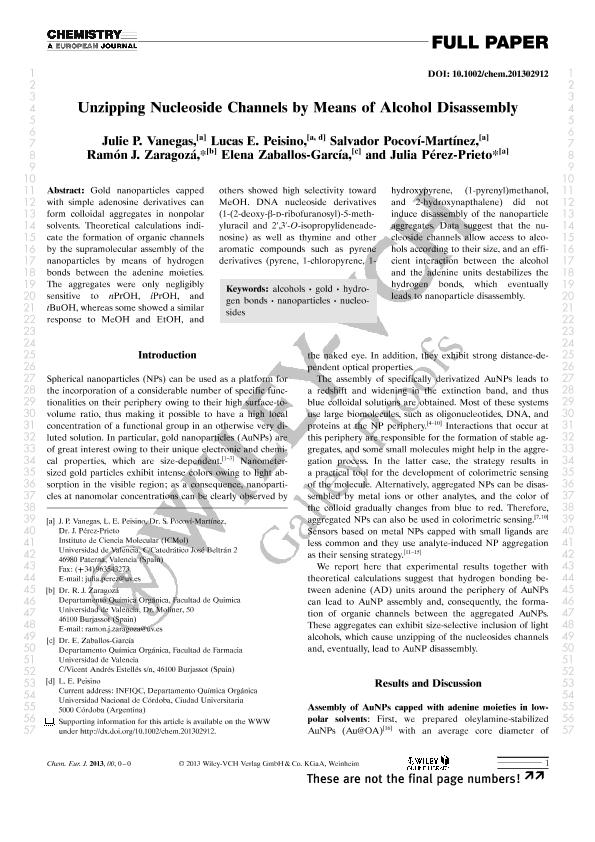Mostrar el registro sencillo del ítem
dc.contributor.author
Vanegas, Julie P.
dc.contributor.author
Peisino, Lucas Ernesto

dc.contributor.author
Pocoví Martínez, Salvador
dc.contributor.author
Zaragozá, Ramón J.
dc.contributor.author
Zaballos García, Elena
dc.contributor.author
Pérez Prieto, Julia
dc.date.available
2017-10-05T18:25:28Z
dc.date.issued
2013-10
dc.identifier.citation
Vanegas, Julie P.; Peisino, Lucas Ernesto; Pocoví Martínez, Salvador; Zaragozá, Ramón J.; Zaballos García, Elena; et al.; Unzipping nucleoside channels by means of alcohol disassembly; Wiley VCH Verlag; Chemistry - A European Journal; 19; 48; 10-2013; 16248-16255
dc.identifier.issn
1521-3765
dc.identifier.uri
http://hdl.handle.net/11336/25996
dc.description.abstract
Gold nanoparticles capped with simple adenosine derivatives can form colloidal aggregates in nonpolar solvents. Theoretical calculations indicate the formation of organic channels by the supramolecular assembly of the nanoparticles by means of hydrogen bonds between the adenine moieties. The aggregates were only negligibly sensitive to nPrOH, iPrOH, and tBuOH, whereas some showed a similar response to MeOH and EtOH, and others showed high selectivity toward MeOH. DNA nucleoside derivatives (1-(2-deoxy-β-D-ribofuranosyl)-5-methyluracil and 2′,3′-O-isopropylideneadenosine) as well as thymine and other aromatic compounds such as pyrene derivatives (pyrene, 1-chloropyrene, 1-hydroxypyrene, (1-pyrenyl)methanol, and 2-hydroxynapthalene) did not induce disassembly of the nanoparticle aggregates. Data suggest that the nucleoside channels allow access to alcohols according to their size, and an efficient interaction between the alcohol and the adenine units destabilizes the hydrogen bonds, which eventually leads to nanoparticle disassembly.
dc.format
application/pdf
dc.language.iso
eng
dc.publisher
Wiley VCH Verlag

dc.rights
info:eu-repo/semantics/openAccess
dc.rights.uri
https://creativecommons.org/licenses/by-nc-sa/2.5/ar/
dc.subject
Alcohols
dc.subject
Gold
dc.subject
Nucleosides
dc.subject
Nanoparticles
dc.subject.classification
Otras Ciencias Químicas

dc.subject.classification
Ciencias Químicas

dc.subject.classification
CIENCIAS NATURALES Y EXACTAS

dc.title
Unzipping nucleoside channels by means of alcohol disassembly
dc.type
info:eu-repo/semantics/article
dc.type
info:ar-repo/semantics/artículo
dc.type
info:eu-repo/semantics/publishedVersion
dc.date.updated
2017-10-03T18:23:16Z
dc.journal.volume
19
dc.journal.number
48
dc.journal.pagination
16248-16255
dc.journal.pais
Alemania

dc.journal.ciudad
Weinheim
dc.description.fil
Fil: Vanegas, Julie P.. Universidad de Valencia; España
dc.description.fil
Fil: Peisino, Lucas Ernesto. Universidad de Valencia; España. Consejo Nacional de Investigaciones Científicas y Técnicas. Centro Científico Tecnológico Conicet - Córdoba. Instituto de Investigaciones en Físico-química de Córdoba. Universidad Nacional de Córdoba. Facultad de Ciencias Químicas. Instituto de Investigaciones en Físico-química de Córdoba; Argentina
dc.description.fil
Fil: Pocoví Martínez, Salvador. Universidad de Valencia; España
dc.description.fil
Fil: Zaragozá, Ramón J.. Universidad de Valencia; España
dc.description.fil
Fil: Zaballos García, Elena. Universidad de Valencia; España
dc.description.fil
Fil: Pérez Prieto, Julia. Universidad de Valencia; España
dc.journal.title
Chemistry - A European Journal
dc.relation.alternativeid
info:eu-repo/semantics/altIdentifier/doi/http://dx.doi.org/10.1002/chem.201302912
dc.relation.alternativeid
info:eu-repo/semantics/altIdentifier/url/http://onlinelibrary.wiley.com/doi/10.1002/chem.201302912/abstract
Archivos asociados
